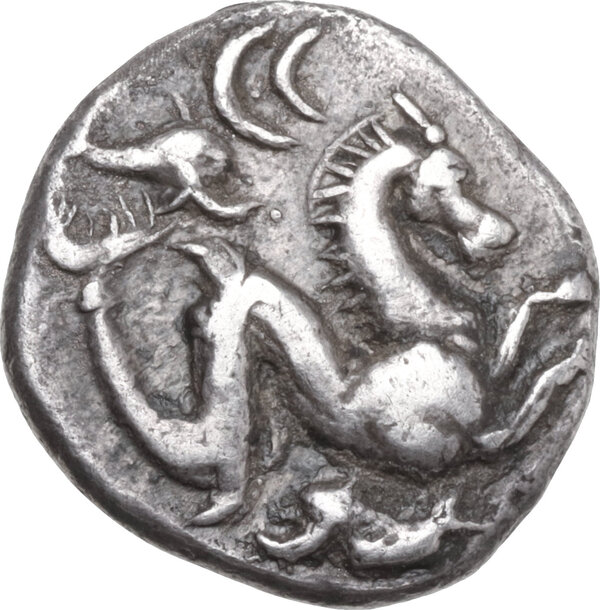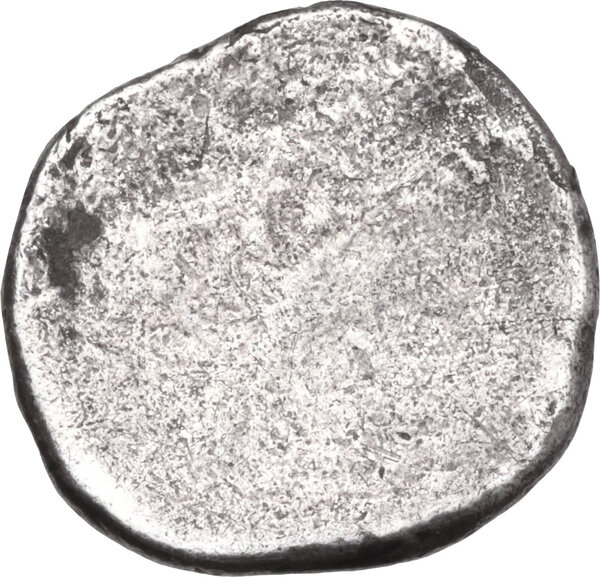









拍品号 12:
Greek Italy. Coastal Etruria, Luca (?). AR 10 Units, 3rd century BC. Obv. Hippocamp right; above, dolphin right and CC; below, dolphin left. Rev. Blank. Vecchi EC Series 8.18 (this coin); HN Italy 98; HGC 1 65. 3.9 g. 16.5 mm. RR. Very rare and choice example for issue. Nice tone. Good VF.
The present coin, struck during the third century BC, represents a period in which Roman influence was increasingly prevalent in Etruria, yet it retains several defining features of Etruscan numismatics. Etruscan coinage of this era is characterized by uniface strikes—unlike the contemporaneous Greek coinage, which was typically struck on both sides. The present example was struck with a single hammer die, leaving the reverse with the natural impression of the striking surface. Notably absent are inscriptions naming the issuing authority, a hallmark of Greek coinage, and instead, Etruscan coins frequently feature numerals, as seen here with the mark of value 'X,' indicating 10 units. These units likely correspond to the Roman bronze as, the standard denomination adopted by various Italic peoples.
The attribution of this hippocamp issue has been subject to scholarly debate. Previously, it had been tentatively attributed to the mints of Populonia or Vetulonia, key centers in southwestern Etruria. However, recent numismatic evidence from hoard finds supports Luca as the more probable mint for this series.
Ex Numismatica Ars Classica 6, 11 March 1993, lot 6.
The city of Luca, originally settled by the Ligurians, is believed to derive its name from the Ligurian term luk, meaning 'marshy place.' By the fifth century BC, Luca's control oscillated between various factions, notably the Etruscans, who by the fourth century BC appeared to have solidified their dominance over the city. Historically significant, Luca offered refuge to Ti. Sempronius Longus and his decimated Roman forces following Hannibal’s decisive victory at the Battle of the Trebia in 218 BC. Subsequently, in 177 BC, Luca was formally refounded as a Roman colony, marking the onset of the city’s full Romanization, which coincided with the broader decline of Etruscan culture throughout the region.The present coin, struck during the third century BC, represents a period in which Roman influence was increasingly prevalent in Etruria, yet it retains several defining features of Etruscan numismatics. Etruscan coinage of this era is characterized by uniface strikes—unlike the contemporaneous Greek coinage, which was typically struck on both sides. The present example was struck with a single hammer die, leaving the reverse with the natural impression of the striking surface. Notably absent are inscriptions naming the issuing authority, a hallmark of Greek coinage, and instead, Etruscan coins frequently feature numerals, as seen here with the mark of value 'X,' indicating 10 units. These units likely correspond to the Roman bronze as, the standard denomination adopted by various Italic peoples.
The attribution of this hippocamp issue has been subject to scholarly debate. Previously, it had been tentatively attributed to the mints of Populonia or Vetulonia, key centers in southwestern Etruria. However, recent numismatic evidence from hoard finds supports Luca as the more probable mint for this series.
起拍价 € 2000
当前出价 € 6500
出价数: 20
无可供出售
当前出价 € 6500
出价数: 20
无可供出售





